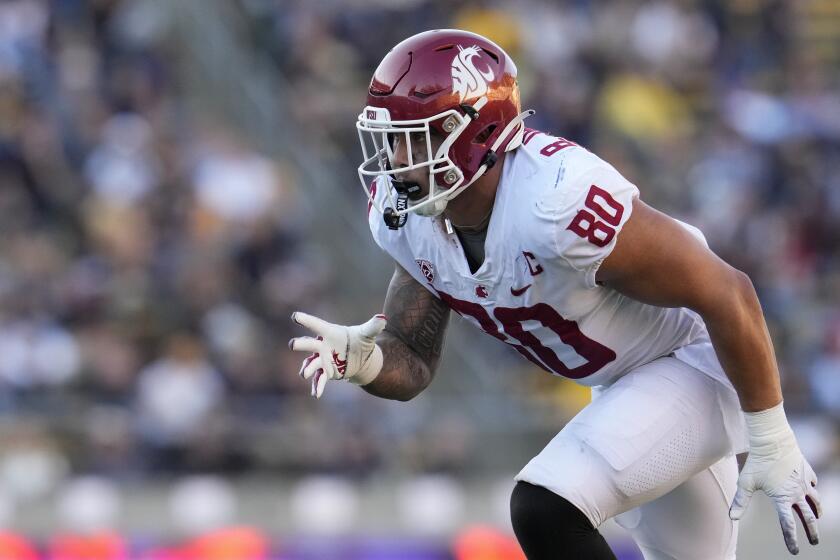The TV Deal the NBA Wishes It Had Not Made
Roughly once a month, the NBA cuts 31 checks to NBA teams as revenue from its multibillion-dollar national television contract.
There are only 30 NBA franchises, so who gets the extra check?
The money goes to brothers Ozzie and Dan Silna, co-owners of the long-forgotten ABA team, the Spirits of St. Louis.
Thirty years ago, Ozzie Silna, with attorney Donald Schupak, negotiated a deal that cleared the way for the ABA to merge with the NBA. It ranks as one of the best sports deals in modern times, one that has paid the Silnas about $168 million and continues to pay off.
“I would have loved to have an NBA team,” said Ozzie Silna, 73, a Malibu resident and environmental activist. “But if I look at it retrospectively over what I would have gotten, versus what I’ve received now, then I’m a happy camper.”
Part of the Silnas’ deal called for them to receive one-seventh of the annual TV revenue from each of the four ABA teams entering the NBA. The deal turned out to be so lucrative that several NBA teams have tried to break it, without success.
“We honor the deal,” said Donnie Walsh, the Indiana Pacers’ chief executive. “I can’t say we haven’t met and tried to settle it. But it’s the greatest deal known to man. What more can you say?”
The key line in the Silnas’ TV contract that makes NBA executives cringe reads: “The right to receive such revenues shall continue for as long as the NBA or its successors continues in its existence.”
In other words, the deal lasts as long as the NBA does.
Another key component is that Silna, anticipating the NBA expanding, capped the brothers’ portion of shared television revenue at a maximum of 28 teams. The other NBA teams share their revenue among all 30 teams.
The Silnas’ contract stands ironclad, despite occasional court challenges. Harry Weltman, former general manager of the Spirits, argued to the Supreme Court in 1991 that he was entitled to a share of the revenue to no avail.
Still, the four ABA teams now in the NBA -- the Denver Nuggets, Indiana Pacers, New Jersey Nets (formerly the New York Nets) and San Antonio Spurs -- have spent plenty in legal fees searching for wiggle room out of the Silnas’ contract.
“I think nearly every single attorney and sports executive from those four franchises has taken a look at the deal to see if they can break it,” said Gary Hunter, a former Nuggets executive. “I’ve yet to talk to anybody who can say it can be broken. Every year, when it came down to take a look at the budgeting process we would all just shake our heads.”
Three decades ago when the Silnas struck their deal, the renegade ABA, known for its red-white-and-blue ball, three-point shots and star Julius Erving, was struggling financially.
In 1976 the ABA reached a merger deal with the NBA. The NBA agreed to take four of the six teams from the dismantling ABA. The Spirits and the Kentucky Colonels were not invited to join the league. However, the ABA owners needed to reach unanimous approval for the merger to take place.
John Y. Brown, owner of the Kentucky Colonels, quickly accepted a $3.3-million buyout as compensation. That deal was also offered to the Silnas.
But Ozzie Silna kept haggling for more, and he finally reached a deal in a swank Massachusetts hotel room. The Silnas would get $3 million, plus a share of the TV revenue from the four teams entering the NBA.
“When we accepted the arrangement, the big thing was that the NBA had television” and the ABA didn’t, said Silna. “But still, the TV revenue was minuscule compared with baseball and the NFL.”
Initially, the contract netted the Silnas about $300,000 a year as the NBA struggled with spotty attendance and weak TV ratings until the ‘80s, when Magic Johnson, Larry Bird and Michael Jordan catapulted the league to a higher profile.
As the NBA’s popularity rose, so did the league’s TV contract and the Silnas’ cut. For the NBA’s last contract, they averaged $15 million a year.
“The process never even entered our minds of how high it would get,” Ozzie Silna said. “We just wanted a piece of the action.”
They are due an even larger jackpot from the NBA’s current contract, which began in 2002. That six-year, $4.6-billion deal with ABC/ESPN and TNT could earn them upward of $24 million annually, according to Silna.
Without having to dole out salaries or money on stadium leases, the Silnas earn more each season than most NBA teams.
Silna is quick to point out that today’s NBA teams are worth hundreds of millions. Indeed, the Lakers are worth $529 million, and the lowly New Orleans Hornets are valued at $225 million, according to Forbes.
The irony is that Ozzie Silna said he never thought the Spirits would be one of the ABA teams that folded.
The Silnas, who originally earned their money as textile manufacturers, purchased the North Carolina franchise and moved it to St. Louis in 1974. The colorful team featured future NBA players Marvin Barnes, Maurice Lucas and Moses Malone and young radio announcer Bob Costas.
Attendance stagnated in the team’s second year, and it soon became apparent the Spirits would not survive the impending merger. In all, the Silnas spent about $5 million on the Spirits.
In 1982, after several years of cashing TV checks, the Silnas came close to accepting a new buyout. The NBA offered them $5 million over eight years, but the Silnas countered with a demand of $8 million over five.
The league balked at that number, so the Silnas have kept cashing in.
More to Read
Get our high school sports newsletter
Prep Rally is devoted to the SoCal high school sports experience, bringing you scores, stories and a behind-the-scenes look at what makes prep sports so popular.
You may occasionally receive promotional content from the Los Angeles Times.






